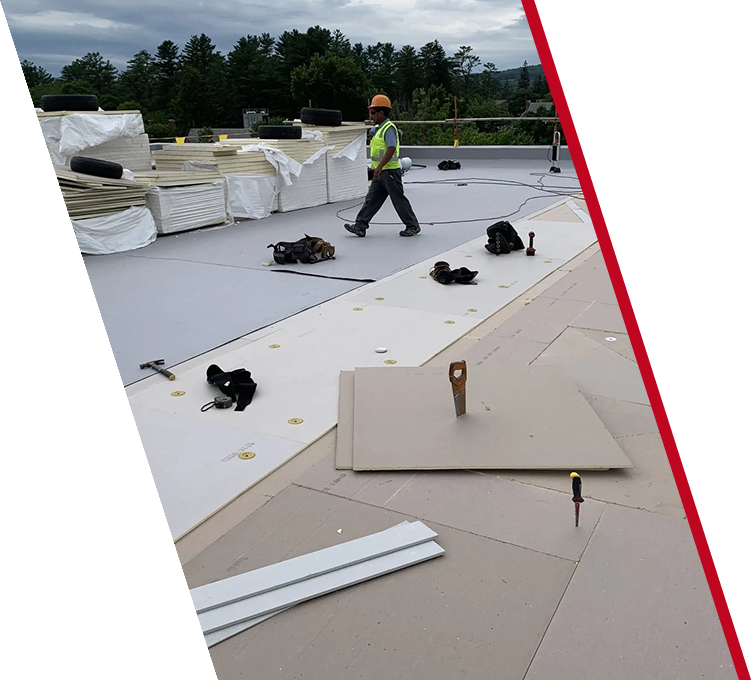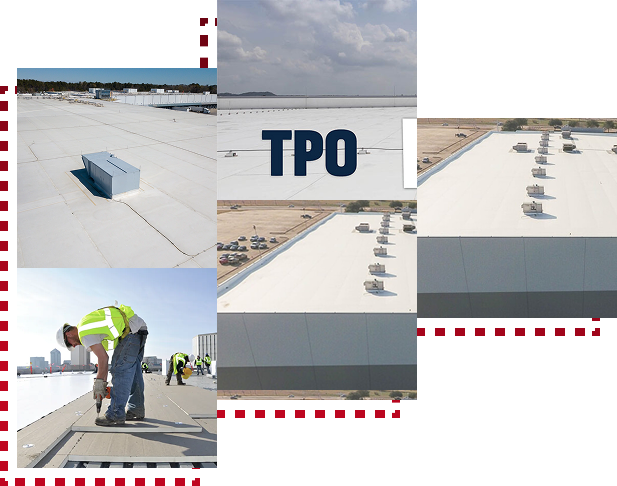TPO Roofing Installation
#1 TPO Roofing Installation in St. Louis

What is TPO Roofing?
Thermoplastic Polyolefin (TPO) roofing is a popular choice for flat and low-slope roofs because it uses a single, durable white membrane that keeps buildings and commercial establishments cooler in hot weather. During professional TPO roofing St Louis, expert contractors lay down rigid insulation boards and then roll out the flexible white membrane, securing it with fasteners or strong adhesives. The seams are heat-welded to form a tight, waterproof, and wind-resistant seal. This clean, bright surface reflects harsh UV rays, resists mold, algae, and dirt buildup, helping lower energy bills, and extend roof life. When it comes to the installation of TPO roofing, experience matters the most. Reputable TPO roofing companies follow a detailed process that includes inspecting the existing structure, preparing the surface, and applying the membrane with care. Every step, from insulation placement to seam welding, is done to ensure long-lasting performance.
Did you search ‘TPO roofing near me’ from St. Louis? You’re in luck. At STL Roof Rescue, our expert TPO roofing contractors are highly trained in modern TPO roofing installation and repair methods, serving St. Louis, St. Charles, Ballwin, Chesterfield, St. Peters, and surrounding areas.

Benefits of TPO Roofing Installation in St. Louis
The installation of TPO roofing by a skilled technician ensures your building stays cool, leak free, and energy efficient- perfect for the weather of St. Louis, MO.
Durable against tears and punctures
Heat-welded seams prevent leaks.
Flexible for building movement
Reflective membrane lowers energy consumptions.
Low maintenance saves repair costs
Eco-friendly and recyclable material
HVAC system-friendly

TPO vs PVC Roofing- Pros and Cons
When comparing flat roof systems, TPO vs PVC roofing is one of the most common debates among property owners. TPO has quickly gained popularity in St. Louis because it is affordable, energy-efficient, and relatively simple to install. Many property owners searching for reliable TPO roofing contractors are attracted to its reflective surface, which helps reduce cooling costs. Also, the installation of TPO roofing is straightforward, and many companies offer cost-effective solutions compared to other systems. However, while TPO is budget-friendly, its durability may not match the decades-long track record of PVC.
PVC roofing , on the other hand, is also a single-ply membrane solution, well known for its chemical resistance, fire rating, and ability to perform under harsh conditions. Yes, it is often more expensive than TPO, but its long-term reliability can make up for the higher upfront cost. PVC roofing can be ideal for restaurants, factories, and healthcare facilities where exposure to grease, chemicals, or heavy foot traffic is common. For property owners seeking a low-maintenance and proven roofing solution, PVC remains one of the most dependable options on the market.
Comparison of TPO Roofing Vs EPDM
When deciding between TPO roofing vs EPDM, property owners should focus on cost, energy efficiency, and durability. TPO (Thermoplastic Polyolefin) is a single-ply membrane that reflects sun.light, reducing cooling costs during hot St. Louis summers. It is affordable, eco-friendly, and quick to install. TPO is especially popular for newer buildings and businesses seeking long-term energy savings.
EPDM (Ethylene Propylene Diene Monomer) is a rubber roofing membrane valued for flexibility and performance in extreme temperature changes. It adapts well to older buildings or complex rooftops where durability and stretch are critical. With proper EPDM roofing installation, the system can last for decades with minimal maintenance.
Both TPO and EPDM roofing offer unique advantages. TPO excels in energy efficiency and cost-effectiveness, while EPDM provides flexibility, longevity, and reliability in challenging conditions. Choosing the right system depends on building type, roof design, and performance priorities. Professional installation ensures seams, drainage, and thermal movement are properly addressed, maximizing the lifespan and effectiveness of either roofing type.

Get Affordable TPO Roofing Services in St Louis Today
Looking for ‘TPO roofing contractors near me’ or reliable TPO roofing services St. Louis? Our team specializes in TPO roofing installation, EPDM roofing installation, TPO roof repair and other TPO roofing services in the designated areas. Our skilled roofing technicians make sure every seam, drainage, and detail is handled with care, delivering energy-efficient, long-lasting roofing solutions that stand up to the local climate. We focus on protecting your property, and extending the lifespan of your roof with expert care. Contact STL Roof Rescue TODAY.
Why STL Roof Rescue is the Top TPO Roofing Contractor in St. Louis
Expert TPO Roofing Installation you can rely on
- Customized TPO roofing installation for every building
- Expert Roofing Contractor, also specializing in PVC and EPDM Roofing Installation
- Licensed, and experienced TPO roofing company in St Louis that always maintains industry standards for roofing.
- Long-term warranties ensure lasting roof protection
- Ongoing maintenance keeps your roof worry-free

Installation of TPO Roofing
Roof Tear-Off and Deck Preparation
The old roofing layers are removed carefully, and the deck is inspected and repaired if necessary. This ensures a base foundation for TPO roofing installation.
Insulation Installation
High-quality insulation boards are installed to improve energy efficiency and provide a stable base for the TPO membrane, enhancing thermal performance and durability.
TPO Membrane Installation
The TPO membrane is laid across the roof surface, cut to fit precisely, and positioned to cover the entire deck. Proper alignment ensures a leak-free and durable TPO roof.
Seam Welding and Quality Checks
All seams are heat-welded and inspected to ensure watertight connections. Final quality checks confirm proper installation, durability, and adherence to TPO roofing standards.
Step 01
Roof Tear-Off and Deck Preparation
The old roofing layers are removed carefully, and the deck is inspected and repaired if necessary. This ensures a base foundation for TPO roofing installation.
Step 02
Insulation Installation
All seams are heat-welded and inspected to ensure watertight connections. Final quality checks confirm proper installation, durability, and adherence to TPO roofing standards.
Step 03
TPO Membrane Installation
The TPO membrane is laid across the roof surface, cut to fit precisely, and positioned to cover the entire deck. Proper alignment ensures leak-free and durable TPO roofing.
Step 04
Seam Welding and Quality Checks
All seams are heat-welded and inspected to ensure watertight connections. Final quality checks confirm proper installation, durability, and adherence to TPO roofing standards.
Roof size, slope, insulation needs, and the condition of the existing deck all impact the final price. Every project is unique, and careful evaluation ensures that property owners get the best value for their investment. What makes TPO the perfect fit for commercial roofs is not just affordability but also its long-term benefits. With professional installation, it enhances energy efficiency, withstands St. Louis weather extremes, and reduces repair needs over time. Choosing the right TPO roofing contractor in St. Louis ensures the system performs reliably for decades.
At STL Roof Rescue, we provide affordable TPO roofing services in St. Louis along with metal roofing, metal coating, fascia and soffit repair, roof inspections, repairs, installations, and replacements. We also assist property owners in roof insurance and storm damage claims, helping to make the process smooth and stress-free.
TPO Roofing Cost in St. Louis
Contact us for a Consultation
Fill out the form below and one of our experts will call you within 24 hours.
Get Your Free QUOTE for TPO Roofing St Louis.
Looking for reliable TPO roofing Services in St. Louis? Get a free quote from STL roof rescue today. We provide expert TPO roofing installation, repairs, and maintenance tailored to your building’s needs. Contact us to discuss your project, receive an accurate estimate, and ensure long-lasting, energy-efficient roofing solutions.
Proudly Serving!
St. Louis, St. Charles, Ballwin, Chesterfield, Fenton, St. Peters, and surrounding areas.
Frequently asked Questions
Roofing and exterior work can be a complex process. We try to take out the guesswork by answering some frequently asked questions.
Is TPO roofing a good choice for St. Louis weather?
TPO is a single-ply membrane widely used in commercial and industrial buildings. It’s known for durability, energy efficiency, and ease of TPO roofing installation. Property owners in St. Louis prefer it for its reflective surface, which helps reduce cooling costs, and its resistance to UV rays, chemicals, and ponding water. Installing a TPO roof requires skilled professionals, so hiring an experienced TPO roofing contractor ensures proper installation, longevity, and performance. With the right materials and professional care, TPO provides a reliable, long-lasting roofing solution.
What’s the average cost of a TPO roof?
TPO roofing cost depends on factors like roof size, slope, insulation, and labor complexity. In St. Louis, a typical project often falls between $7,000 and $15,000, though exact pricing varies per building. Other factors, such as old roof removal, roof deck condition, and material thickness, also influence the final cost. Consulting an experienced TPO roofing contractor ensures accurate estimates, proper TPO roofing installation, and long-term durability.
What are the disadvantages of a TPO roof?
While TPO offers benefits like energy efficiency and durability, it does have some limitations. Improper Installation of TPO roofing can lead to seam issues, leaks, or reduced lifespan. Extreme temperatures may also stress the membrane if not correctly installed, and UV exposure over time can cause minor wear. Using certified TPO roofing contractors in St. Louis mitigates these risks, ensuring seams are welded properly, insulation is installed correctly, and building codes are met.
How many years does a TPO roof last?
A professionally installed TPO roof can last for decades with proper care. Lifespan depends on quality of materials, installation, and maintenance practices. Experienced TPO roofing contractors in St. Louis ensures seams, insulation for TPO roofing, and membrane are installed correctly, reducing the risk of leaks or premature wear. Regular inspections, cleaning, and timely repairs also extend roof life. While environmental factors like sun, wind, and temperature shifts can affect longevity, TPO remains a durable, energy-efficient choice for commercial and residential buildings.
Trusted by Homeowners Across St. Louis
Don’t just take our word for it—our customers consistently rate us 5 stars for fast service, honest pricing, and high-quality workmanship.
“Very happy with the work completed on my commercial property. Great communication throughout and they delivered as promised. I will have them look at my other property as well and will recommend to friends and colleagues.”
Commercial Building Owner

Industry leaders rely on our unparalleled workmanship and unwavering commitment to excellence. Trust is earned through consistently delivering top-notch quality and dedication
We had birds nesting in our soffits and water leaking behind our gutters. These guys fixed it all in one day. Highly recommend!
Home Owner

Industry leaders rely on our unparalleled workmanship and unwavering commitment to excellence. Trust is earned through consistently delivering top-notch quality and dedication